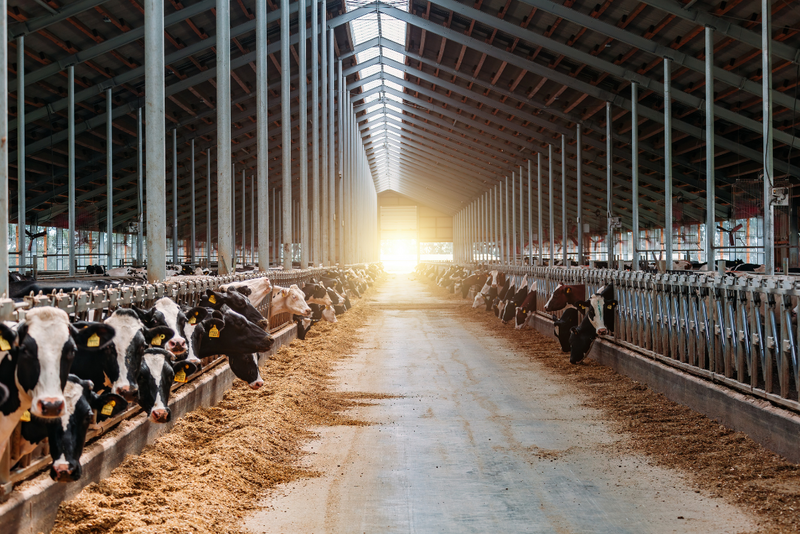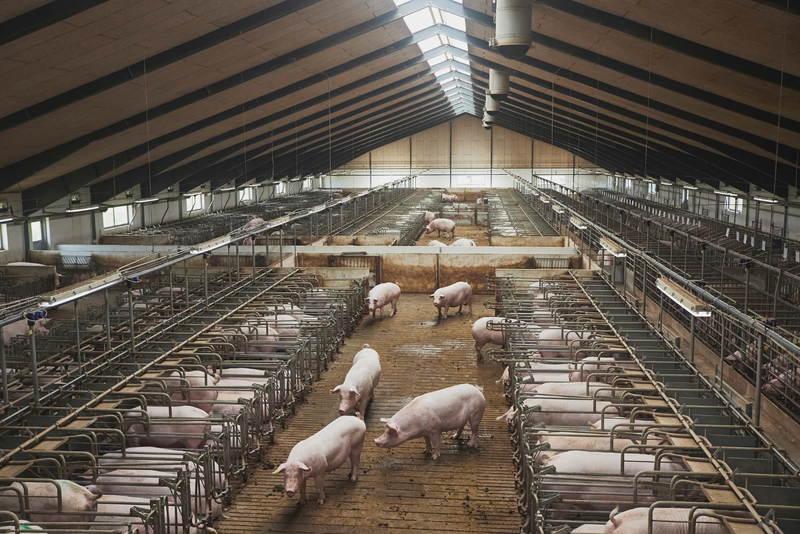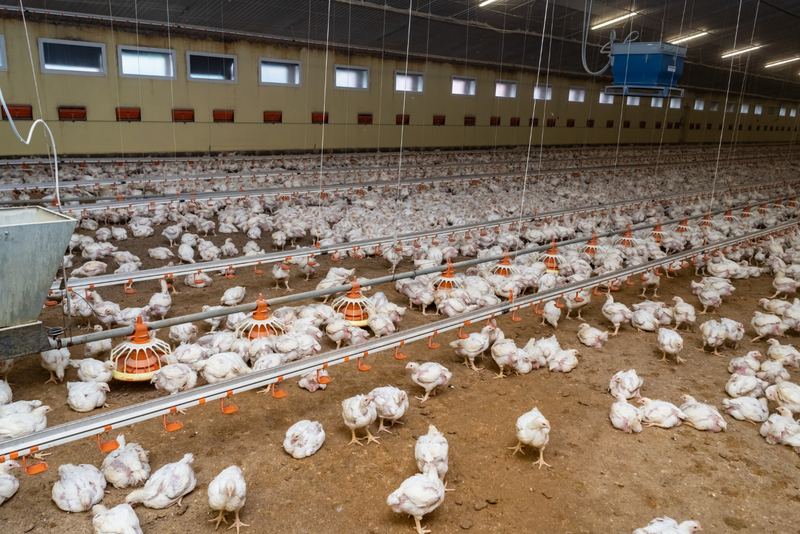The Impact of Barn Climate in Livestock Farming on Animal Welfare and Efficiency

Whether cattle, pigs, or poultry – global meat consumption continues to rise. Worldwide demand for cow’s milk is also increasing. This makes it all the more important to ensure that every step of the production process is both animal-friendly and sustainable. And it all begins in the barn. A healthy barn climate means much more than just “fresh air.” Temperature, humidity, and air quality significantly influence the well-being and performance of farm animals. Even slight deviations can cause stress. At the same time, optimal climate conditions are a decisive factor for efficiency in livestock farming. But what exactly matters here?
Why Barn Climate Matters in Large-Scale Livestock Farming
Globally, livestock numbers can be estimated at around 1.6 billion cattle and 1.4 billion pigs. The largest dairy barns in Western Europe house up to 2,000 animals, while pig farms can reach up to 20,000 animals. In China, the largest known dairy facility operates with around 100,000 cows. Especially in large-scale operations, barn climate plays a central role.
Key factors such as temperature, relative humidity, CO₂, ammonia (and other harmful gases), air velocity, and differential pressure directly influence:
- Feed intake and weight gain
- Milk yield and fertility
- Susceptibility to disease
- Barn hygiene and emissions control
Continuous and precise measurement of these parameters is therefore essential. The following table illustrates how each parameter affects barn climate and animal welfare.
Key Parameters for Barn Climate
| Parameter | Relevance in Barn Climate |
| Temperature (T) | Heat balance, heat stress, air warming |
| Relative Humidity (RH) | Litter quality, THI, pathogens |
| CO2 | Air quality, animal health, indicator for fresh air supply |
| Ammonia (NH₃) | Mucous membranes, respiratory diseases, emissions control |
| Air Velocity | Heat stress control, comfort ventilation |
| Differential Pressure | Ventilation zones, inlet regulation, filter monitoring |
Temperature-Humidity Index (THI) as a Key Indicator of Heat Stress
An important parameter for assessing and evaluating barn climate in livestock farming is the THI (Temperature-Humidity Index).
The THI combines temperature and relative humidity to describe the heat load experienced by animals in the barn. As the THI value increases, animals may suffer more from heat stress – even if the temperature alone does not yet appear excessively high.
The formula for calculating THI is as follows: THI = T – (1.8 × T + 32) – (0.55 – 0.0055 × RH) × (1.8 × T – 26)
- T = air temperature in °C
- RH = relative humidity in %
The resulting value indicates the level of strain on animals caused by the combined effect of humidity and temperature. The THI helps determine the point at which the barn climate becomes stressful or even harmful to animal health. The response to heat stress varies depending on the animal species, genetic line, and environmental adaptation. Nevertheless, it always has a significant impact on animal health and performance.
The impact of Heat Stress on Major Livestock Species
Dairy Cows
| THI Value | Assessment | Impact on Cows |
| < 68 | Comfort zone | No heat stress |
| 68 – 72 | Mild heat stress | First performance losses, cows begin panting more frequently |
| 73 – 79 | Moderate heat stress | Reduced feed intake, noticeable decrease in milk yield |
| 80 – 89 | Severe heat stress | Strongly reduced performance, fertility problems, increased health risks |
| ≥ 90 | Life-threatening heat stress | Acute risk to animal welfare and survival |


Fattening Pigs
| THI Value | Assessment | Impact on Pigs |
| < 70 | Comfort zone | Normal behaviour, no stress |
| 70 - 74 | Mild heat stress | Animals lie stretched out more often, first signs of restlessness |
| 75 – 79 | Moderate heat stress | Feed intake decreases, respiratory rate increases |
| 80 – 84 | Severe heat stress | Panting, circulatory strain, reduced performance |
| ≥ 85 | Acute danger | Risk of heatstroke, life-threatening condition |
Broiler Poultry
| THI Value | Assessment | Impact on Pigs |
| < 70 | Comfort zone | Normal behaviour, no stress |
| 70 - 75 | Mild heat stress | Increased respiration rate, birds spread wings |
| 76 – 80 | Moderate heat stress | Reduced feed intake, slower growth |
| 81 – 85 | Severe heat stress | Noticeably higher mortality possible |
| ≥ 86 | Acute danger | High mortality, emergency measures required |
Note: All values above are guideline ranges. Factors such as barn climate, stocking density, air movement, and animal age further influence when heat stress occurs.

Legal Framework
In addition, the quality of the barn climate – including temperature, humidity, air quality, and ventilation – is regulated by law. Especially within the EU, strict and binding climate limits for animal housing apply. Worldwide, corresponding regulations and recommendations are also gaining importance. While the focus still lies more on productivity than on animal welfare in many regions, a trend reversal is emerging – albeit for different reasons. In the USA, pressure from major food retailers is increasingly shifting attention to animal welfare standards, while in Asia, disease prevention plays a much greater role. Import requirements, particularly from the EU, also indirectly affect regional regulatory mechanisms.
General requirements (for all livestock species)
In Austria, regulations are set out in the Animal Welfare Act (TSchG) and the 1st Animal Husbandry Ordinance (1. ThVO). These provisions are partly general and partly species-specific. The central points are:
- Air quality: Barn air must be such that animals do not suffer permanent health damage or significant stress (e.g., from dust, ammonia, CO₂).
- Temperature: Must remain within an animal-appropriate range – adapted to age, species, breed, and physiological condition (e.g., piglets vs. fattening pigs).
- Humidity & drafts: Must not cause stress or promote disease.
- Ventilation: In the case of mechanical ventilation (fans), emergency ventilation is mandatory if a technical failure occurs.
- Lighting & barn climate: Must be checked regularly.
(Legal basis: § 18 TSchG; 1. ThVO – General Provisions)
Sensors in the Barn – What Really Matters
To control barn climate in an animal-friendly, efficient, and legally compliant way, powerful and reliable sensor technology is indispensable. Sensors used in livestock housing are often exposed to extreme environmental conditions such as dust or ammonia. Their accuracy has a decisive impact on animal health and plays a key role in the efficiency of farm operations.
What should you look for?
- Resistance to dust and ammonia
- Long-term stability
- Robust housing
- Easy integration into control systems
- Calibratable
- Compensation for temperature and humidity
The challenge lies not only in selecting suitable sensors, but also in their strategic placement, integration, and maintenance. In the long term, high-quality sensor solutions not only improve animal health, but also increase economic efficiency and sustainability. E+E Elektronik sensors provide targeted support in controlling barn climate – for the animals, the environment, and operational efficiency.
Read more about sensor technology for a stable barn climate.